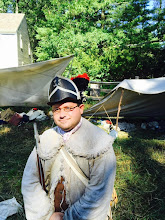 I acquired this wonderful image of two adorable brothers with matching outfits from my friend Marti Jones, who is a dealer and President of the Photographic Historical Society of New England. Please visit their site at http://www.phsne.org. This is one of those photos that I fell in love with and just had to have it! There is an indication that these two young boys, one slightly older than the other, lived in central Massachusetts, since on the back of the image is the imprint of the photographer which reads: "Lawrence, 188 Main Street, Worcester." Images bearing original notations about the person(s) always increases their value, and human interest. This one is inscribed in period ink on the reverse: "For Dear Brother Alonzo..." So it is probable one of these boys was named Alonzo. Just having this information makes an image so much more intriguing to me.
I acquired this wonderful image of two adorable brothers with matching outfits from my friend Marti Jones, who is a dealer and President of the Photographic Historical Society of New England. Please visit their site at http://www.phsne.org. This is one of those photos that I fell in love with and just had to have it! There is an indication that these two young boys, one slightly older than the other, lived in central Massachusetts, since on the back of the image is the imprint of the photographer which reads: "Lawrence, 188 Main Street, Worcester." Images bearing original notations about the person(s) always increases their value, and human interest. This one is inscribed in period ink on the reverse: "For Dear Brother Alonzo..." So it is probable one of these boys was named Alonzo. Just having this information makes an image so much more intriguing to me.Another feature of Civil War era images that can help us date them more exactly are tax revenue stamps that were affixed to images roughly between July 1864 and August 1866. During our Civil War, the carte de visite quickly became the most popular medium of photography for soldiers and civilians to send images to each other. Literally millions of images were produced during this craze, which is lucky for collectors today. Seizing upon this phenomenon, however, was the US Government, which was looking for ways to generate revenue to help pay for the war. Does this sound familiar? :) Anyway, Congress passed an act on June 30, 1864 which added a new tax on all "photographs, ambrotypes, daguerreotypes or any other sun-pictures" to be paid for by gluing a revenue stamp on the back of the photograph. The tax was set at 2 cents for a photograph "with a retail value of not over 25 cents , 3 cents for a photo costing over 25 but not over 50 cents; 5c for photos costing over 50c but not over a dollar; and for each additional dollar or fraction of a dollar, another 5 cents. Photographers were also required to "cancel" or date these stamps when the image was sold to the customer, which can often provide an exact date to a collector of when that image was made. The image posted today has a green two-cent revenue stamp on the back featuring George Washington, which means it only costed the boys' parents 25 cents sometime between 1864-66. Still, this is a priceless image to me!


No comments:
Post a Comment